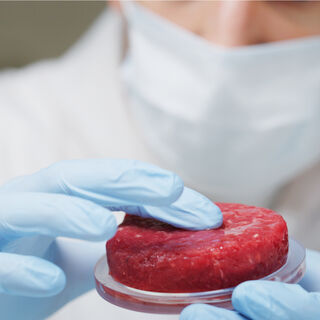
Recently, my inbox contained a news release about cultured chicken. This is not chicken that spent its life going to the great art museums and listening to classical music. "Cultured" referred to the chicken being grown from a cell culture of chicken cells. The article outlined how the chicken was cultured: Living cells are removed from a chicken, and, after various procedures, the cells reproduce to become meat indistinguishable from that of a naturally-born chicken.
The process of forming a filet mignon or chicken breast from a single cell is not simple. An article published in Frontiers of Nutrition described the multistep process. After the biopsy of muscle from a living cow or chicken, the tissue is dissected to release stem cells. These are cells that can transform themselves into different types of cells such as fat, muscle, or nerve. The cells are bathed in fetal bovine serum, a fluid that comes from a dead calf. Note: both the animal cells and calf serum make the end product a non-vegetarian or non-vegan product.
As the cells grow, they are supported by what is called scaffolding, which stretches the muscles and increases their protein contents. While this is going on, the nutrient content of the fluid from which the cells are fed can be modified to decrease, for example, the amount of saturated fat and increase the unsaturated fat content. The process is still very technologically new.
Although the finished products have not appeared in supermarkets yet, they may in the next few years. In January, Bloomberg Businessweek reported that Upside Foods Inc. opened an enormous factory outside Berkeley, Calif. to grow clumps of chicken and beef cells into respective chicken parts and beef.
Factories containing vats of rapidly reproducing chicken or beef cells yet may not replace ranches, but our government is taking this relatively new area of research and food production very seriously. Just last fall, the United States Department of Agriculture awarded $10 million to Tufts University to establish the National Institute for Cellular Agriculture. The center will focus on protein research that, “revolves around the use of a small amount of animal cells to create real meat and other animal proteins, replacing the environmentally damaging practice of raising and slaughtering animals for food.“
Will this novel form of meat, poultry, and eventually fish and seafood be accepted? Of course, many foods new to the eater may undergo a period of rejection before becoming commonplace in the dining room or on the restaurant menu. Sushi, for example, was not found in supermarkets, vending machines, and convenience stores for decades after being introduced to the American public in ethnic or fish restaurants. The idea of eating raw fish was so distasteful to Americans that some people (like my young cousins at the time) could not even look at it. Now, it is a common snack food as well as a gourmet delight. Decades ago, yogurt was something to be avoided unless one liked eating something that sort of looked like sour cream, but was much more sour tasting and watery. Cultivated meat may be accepted more readily as it has the advantage of looking and pretty much tasting like the real thing, and could be distinguished from the naturally raised product.
Cultured animal foods may appeal to anyone who is concerned about the conditions in which the animals that we eat are raised. The impact on the environment of growing animals, as it were, in a vat of broth rather than on pastureland is significantly less (although there is a substantial energy cost to growing the steaks and chicken breasts in vats). About 99 percent of animals used for food are raised as potential factory products, and the conditions in which they are raised make them susceptible to infection. One important benefit to humans consuming animal products generated in a culture is the ability to prevent infections, Salmonella and Listeria, for example, that may be fatal.
But, acceptance of this new form of protein is complicated psychologically, ethically, and religiously. A friend with whom I discussed this told me that she is happy to eat plant-based imitation meat because she knows that even though it might taste somewhat like a burger, it is “only pretend meat.” She is not so sure about a hamburger that is the result of cultivation growth in a gigantic test tube. “It just feels so unnatural to me, but of course it is,” she concluded. Vegetarians and vegans may also have a problem with cultivated meat, since the original cells come from a living animal, and the “broth” in which they are incubated comes from the serum of a fetal animal. Conversely, anyone vegetarian, vegan, or who otherwise sees avoiding harm to an animal as the paramount reason for not eating conventional animal products may welcome cultured meat as a humane alternative.
Religious groups such as Muslims, Jews, Hindus, and Buddhists have been surveyed, and acceptance of meat-eating varies depending on the source of the meat, and for some groups, whether the animal was slaughtered according to the religion’s law and commandments. Interestingly, groups that reject pork would also reject cultivated pork products, and Hindus are less likely to eat beef, as the cow is sacred. But the survey failed to address whether acceptance would be less if the meat were cultured from cells removed from a living animal.
Given the interest and financial investment in producing cultivated meats, each one of us will probably see these products in our supermarkets within a few years. Perhaps it is worthwhile now thinking about whether we will buy or reject a cultivated hamburger or chicken nugget.
Are You Ready to Eat Lab-Grown Meat? - Psychology Today
Read More

No comments:
Post a Comment